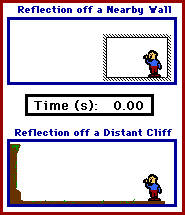Sound which has been reflected off hard, flat surfaces such as a large wall or a distant cliff is called an echo.

Reflection of sound waves off of surfaces is affected by the shape of the surface. Flat or plane surfaces reflect sound waves in such a way that the angle at which the wave approaches the surface equals the angle at which the wave leaves the surface.Hence, Laws of reflection of light apply to sound as well.
Audibility
The word 'audible' refers to being able to be heard. The range of frequencies which a person can hear is known as range of audibility.
Sound frequencies between 20 and 20,000 Hz can be heard by people.
As people get older, the higher frequencies become more difficult to hear.
Ultrasound and Infrasound
Sound with a frequency lower than 20 Hz is called infrasound.
These very low frequency sound wavescan be given off by volcanoes and meterorite explosions.Infrasound is used by some large animals for communication.Whales can communicate over hundreds of miles using infrasound.
Sound with a frequency higher than 20,000 Hz is called ultrasound.Ultrasound echoes are used in Scanning and Range and Direction Finding.Ultrasound in liquids can be used to clean precious or delicate items because the compressions and rarefactions
will shake dirt and unwanted material free without the risk of damage being caused by handling the item.
Pitch and Loudness
The loudness of sound depends on the amplitude of the wave.The bigger the amplitude, the louder the sound.
The pitch of sound (how high the note is)depends on the frequency of the wave.
The higher the frequency, the higher the pitch.
Sound is a longitudinal wave and so it is difficult to show the amplitude and frequency on a diagram. A microphone can be used to change the sound wave into an alternating current which can be displayed as a transverse wave on a CRO.This makes it easier to show the effect of amplitude and frequency on loudness and pitch.
Below is a picture of a sound wave which has been changed into alternating current by a microphone and displayed on a CRO.

If the sound is made louder and with a higher pitch, the shape of the wave changes as shown below.

The amplitude has got bigger because the sound is louder. The frequency has increased
(there are more complete waves in the same time) because the sound has a higher pitch.
this did not help me at all
ReplyDeleteSorry to hear that. Thanks for your comments!!
ReplyDeleteWow that was great
ReplyDelete